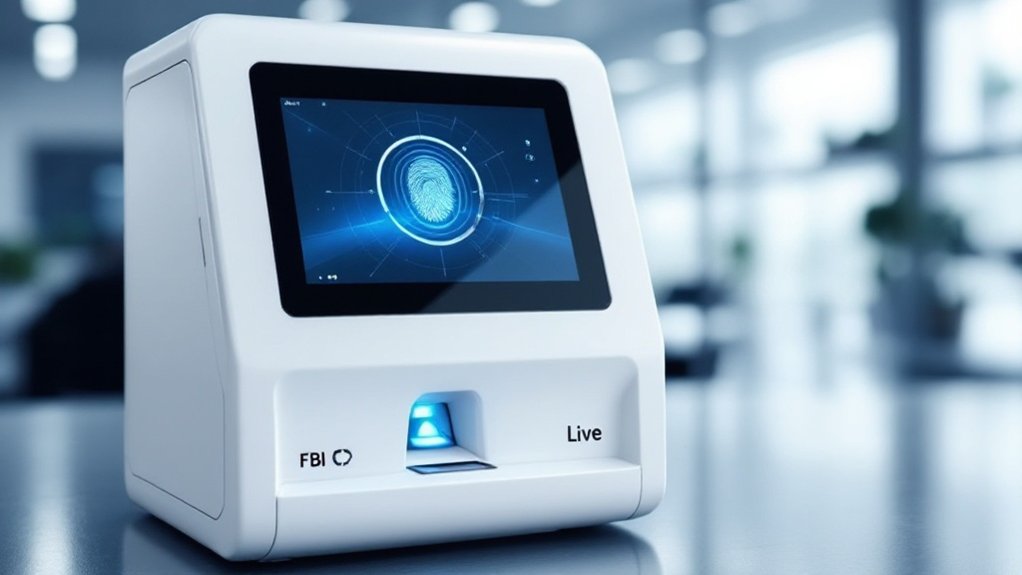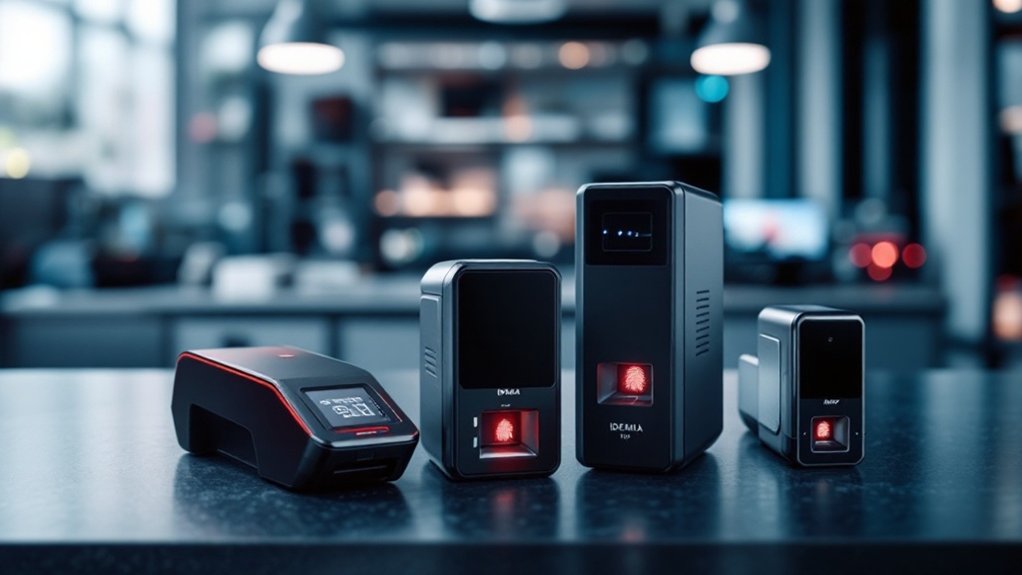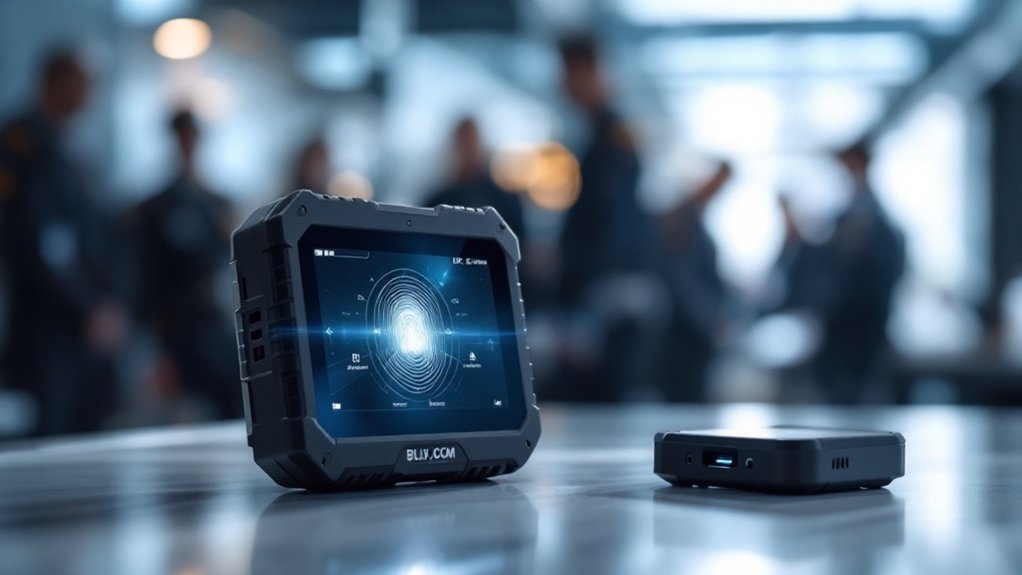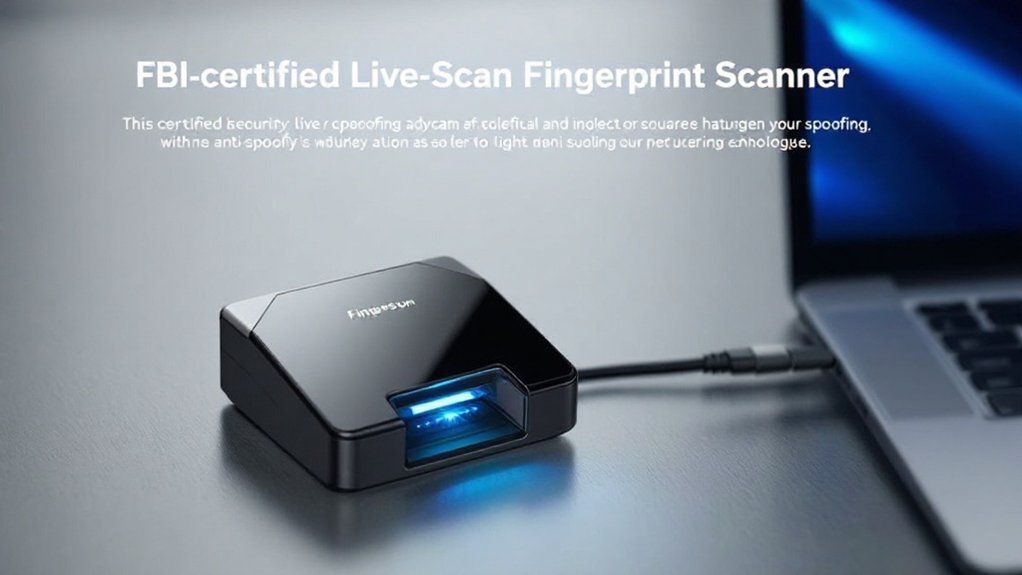When you’re looking for approved live scan fingerprint scanners, you’re seeking devices that meet the FBI’s Appendix F standards for image quality and security. These scanners, like the Aratek A900, guarantee high-quality images and secure data transmission. They’re certified under specific FAP levels, such as FAP 60, which assure seamless integration with federal agencies. By choosing these scanners, you comply with rigorous standards. Continuing, you’ll discover more about their applications and technical specifications.
FBI Certification and Compliance

When considering Live Scan fingerprint scanners, how do you guarantee they meet the necessary standards for accuracy and security? The answer lies in FBI certification, which verifies compliance with rigorous standards outlined in Appendix F of the Next Generation Identification Systems Image Quality Specifications. This certification process ensures that systems meet specific image quality and security requirements, resulting in high-quality fingerprint images and secure data transmission. Certified devices, like the Aratek A900, are approved under FBI Appendix F FAP 60, confirming they meet federal standards. By using certified systems, you can rely on enhanced accuracy, efficiency, and security, which are vital for maintaining compliance with federal regulations. Additionally, systems certified by the FBI, such as those used by providers with FBI certification, can ensure seamless integration with federal and state agencies for background checks.
Key Features of Approved Scanners
How do you guarantee that a Live Scan fingerprint scanner meets the highest standards for accuracy and security? You look for key features like liveness detection, which verifies fingerprints are from a live person, and digital image capture, eliminating the need for ink. Scanners perform quality checks in real-time to confirm high-quality prints, and data encryption protects privacy during transmission. An intuitive user interface makes them easy to use.
Approved scanners also offer high resolution, support various fingerprint types, and are compatible with multiple devices. They are portable and adhere to industry standards. Additionally, they enable electronic submission and real-time processing, reducing errors and increasing speed compared to traditional methods. By utilizing Live Scan technology, these scanners provide a more accurate, efficient, and rapid method of obtaining essential data, which is crucial for background checks and other identification purposes.
Examples of Approved Live Scan Scanners

Approved Live Scan fingerprint scanners are designed to meet stringent standards for accuracy and security, and several models stand out for their reliability and versatility. You’ll find options like Fulcrum Biometrics FbF LiveScan, which is approved by multiple state agencies, and IDEMIA MTop Series, certified by the FBI for global biometric enrollment. Other notable models include Bayometric Live Scan Systems, known for extensive solutions, and Crossmatch Live Scan Scanners, often used in law enforcement. These scanners are indispensable for various applications, ensuring high-quality fingerprint capture and compliance with FBI standards. Additionally, many of these systems are built with rugged designs to withstand harsh environments, making them suitable for use in demanding settings such as booking processes and national ID projects.
Applications and Industries
Live scan fingerprinting is widely applied across numerous industries due to its efficiency, accuracy, and security. You’ll find it in law enforcement for criminal background checks, national agencies like the FBI, and state agencies for employment screening. It’s also used in immigration and air travel for identity verification.
Some key applications include:
- Healthcare and Education: For employment and licensing purposes.
- Regulated Industries: Financial and government sectors for compliance.
- Public Safety: Used by law enforcement for offender enrollment.
- Licensing and Certification: Required for professional licenses in various fields. Additionally, live scan systems support comprehensive background checks by enabling submissions to agencies like the FBI, which is crucial for meeting regulatory requirements across different sectors.
Technical Specifications and Certifications

When selecting a Live Scan fingerprint scanner, it is critical to evaluate its technical specifications and certifications. These scanners typically capture high-resolution images, ensuring accurate identification. They can capture various print types, including rolls and slaps, and some include liveness detection to prevent fake fingers. Encryption methods like AES-256 secure data during transmission. Many scanners are FBI-certified, meeting Appendix F specifications, and some comply with MOSIP standards for interoperability.
Certifications often include state approvals, such as from the California DOJ and Florida FDLE. Live Scan systems are used globally and comply with industry standards for seamless integration with law enforcement systems. They support additional biometrics and offer features like automated capture and real-time feedback.
Benefits and Advantages of Live Scan Scanners
As you consider implementing Live Scan fingerprint scanners, you’ll find that they offer numerous benefits and advantages over traditional methods. Live Scan technology enhances accuracy by minimizing human error and providing clearer images. It also streamlines processes, making it more efficient and convenient.
Some key advantages include:
- Improved Accuracy: Reduces smudging and smearing, guaranteeing high-quality prints.
- Faster Processing: Results are processed quickly, often within minutes.
- Convenience: The process is clean and easy, eliminating messy ink.
- Enhanced Security: Electronic transmission safeguards secure data handling. Additionally, Live Scan allows for the electronic transmission of fingerprints directly to relevant agencies, which significantly speeds up the background check process.
Security Measures and Anti-Spoofing Technologies**

As you explore the security features of live scan scanners, you’ll notice they offer unique identification through fingerprints, which are non-transferable and difficult to forge, enhancing access control security. To prevent spoofing, some live scan devices incorporate anti-spoofing technologies like liveness detection and software-based approaches to differentiate between real and fake fingerprints. By integrating these scanners with existing security systems, you can achieve seamless access control, real-time monitoring, and multi-factor authentication, further bolstering the security of your systems.
Spoof Detection
Spoof detection in fingerprint scanners is a critical security measure designed to prevent unauthorized access by distinguishing between real and fake fingerprints. You’ll encounter various techniques to guarantee the authenticity of fingerprints. Here are some key methods:
- Hardware-Based Detection: Uses temperature and electrical conductivity.
- Software-Based Detection: Analyzes dynamic changes or detects moisture.
- Liveness Detection: Identifies physiological features like heart rate and odor.
- Dynamic Analysis: Processes multiple frames to detect distortions.
These methods help protect against spoofing attacks, validating that only genuine fingerprints are recognized.
Security Features**
When you’re evaluating approved live scan fingerprint scanners, it’s crucial to weigh the robust security features they offer. These scanners provide unique identification through fingerprint patterns, which are non-transferable and securely stored. They also enable real-time verification and can be part of multi-factor authentication systems.
Approved live scan fingerprint scanners incorporate anti-spoofing technologies like liveness detection and counterfeit detection. These methods confirm that only live fingerprints are accepted, enhancing security against presentation attacks. Additionally, these scanners comply with ISO standards for presentation attack detection, guaranteeing they meet rigorous security benchmarks.
Conclusion
You’ve now explored the world of approved live scan fingerprint scanners, where “a picture is worth a thousand words”—in this case, a high-quality fingerprint image. Approved scanners, like those from Fulcrum and Suprema, meet FBI standards and offer features like real-time quality control and anti-spoofing technologies. These devices are pivotal in law enforcement, security, and identity verification, providing accurate and reliable biometric data.

